CBA Research Reports
Council for British Archaeology, 2000. (updated 2020) https://doi.org/10.5284/1000332. How to cite using this DOI
Data copyright © Council for British Archaeology unless otherwise stated
This work is licensed under the ADS Terms of Use and Access.
Primary contact
Council for British Archaeology
92 Micklegate
York
YO1 6JX
UK
Tel: 01904 671417
Resource identifiers
- ADS Collection: 281
- DOI:https://doi.org/10.5284/1000332
- How to cite using this DOI
The Spitalfields Project. Volume 2: The Anthropology - The Middling Sort
Theya Molleson and Margaret Cox with A H Waldron and D K Whittaker
CBA Research Report No 86 (1993)
ISBN 1 872414 08 7
Abstract

The Spitalfields Project came about as a result of the need to clear the crypt of Christ Church, Spitalfields during the restoration of the church. About a thousand skeletons were excavated, including nearly 400 with coffin plate information giving name, age and date of death. Dates of birth ranged from 1646 to 1852, and dates of death from 1729 (when the church was consecrated) to 1852. The known age skeletons have provided the basis for an analysis of growth and ageing processes, and some marked differences from modern samples have been documented.
Reconstruction of the social backgrounds of the named individuals has shown that the majority were of Huguenot descent, and that a large proportion were involved in the silk industry. Some were prosperous master weavers, others were hard working journeymen weavers, who, together with merchants, surgeons, and tradesmen comprised the 'middling sort' of the eighteenth century.
The study has, where possible, integrated the documentary evidence with skeletal characteristics, and burial practices. Such variables as nutrition, oral health, disease, climate, occupation, social, and economic status have been examined in relation to skeletal traits. Obstetric histories were reconstructed, and the reliability of methods of parity assessment were tested.
This report presents the results of the initial examination of the physical anthropology, and the social history of a post-medieval crypt sample.
Contents
- Title pages I
- Title pages II
- Contents (pp i-iv)
- Summaries (pp x-xi)
- Preface (pp 1-4)
- Acknowledgements (pp 5-8)
- Part I (pp 9-92)
- 1. The anthropological sample (pp 9-22)
- 1. Introduction (pp 9)
- 2. Recovery of skeletal material (pp 9-10)
- 3. Preservation (pp 10-18)
- 4. Reconstruction of the historical background (pp 18-20)
- 5. Analysis of the anthropological data (pp 20-22)
- 2. The anthropology of the total sample (pp 23-36)
- 1. The sample (p 23)
- 2. The data analysis (pp 23-36)
- 3. Nutrition (pp 37-48)
- 1. Dietary background (pp 37-41)
- 2. Diet and health (pp 41-48)
- 4. Oral health by D K Whittaker (pp 49-66)
- 1. Introduction (pp 49-50)
- 2. Caries prevalence (pp 50-53)
- 3. Evidence of restorative and surgical dentistry (pp 53-54)
- 4. Artificial dentures and bridge artefacts (pp 54-60)
- 5. Oral pathology (p 60)
- 6. Continuing eruption and the alveolar crest (pp 60-63)
- 7. Diseases of the temporo-mandibular joints (pp 63-66)
- 5. The health of the adults by H A Waldron (pp 67-92)
- 1. Introduction (p 67)
- 2. Osteoarthritis (pp 67-75)
- 3. Other joint diseases (pp 75-77)
- 4. Degenerative disc disease (pp 77-79)
- 5. Diffuse idiopathic skeletal hyperostosis (pp 79-80)
- 6. Other spinal diseases (pp 80-81)
- 7. Paget's disease (pp 81-82)
- 8. Trauma (pp 82-83)
- 9. Infectious disease (pp 83-85)
- 10. Malignant disease (pp 85-86)
- 11. Vascular disease (pp 86-87)
- 12. Spina bifida occulta (p 87)
- 13. Spondylolysis (p 87)
- 14. Autopsies (p 87)
- 1. The anthropological sample (pp 9-22)
- Part II (pp 93-181)
- 6. The named sample (pp 93-112)
- 1. The sample (pp 93-94)
- 2. Huguenot origins (pp 94-97)
- 3. Status: social and economic (pp 97-102)
- 4. Where they lived (pp 102-112)
- 7. The historical and environmental background (pp 113-122)
- 1. The period (p 113)
- 2. The development of the area (pp 113-116)
- 3. The climatic region (pp 116-122)
- 8. Families and relations (pp 123-130)
- 1. Families and relations (pp 123-124)
- 2. Examinations of the physical characteristics of the related individuals (pp 124-130)
- 9. Marriage and fertility (pp 131-144)
- 1. Marital status (p 131)
- 2. Age of marriage (pp 131-132)
- 3. The interval between marriage and first birth (pp 132-133)
- 4. Age at first birth (pp 133-134)
- 5. Family size (pp 134-135)
- 6. Skeletal parity assessment (pp 135-136)
- 7. Childbirth in the 18th and early 19th centuries (pp 136-137)
- 8. Maternal mortality (pp 137-139)
- 9. Birth spacing (pp 139-140)
- 10.Birth control (pp 140-142)
- 11.Age at last birth (pp 142-144)
- 10. The children (pp 145-156)
- 1. Introduction (p 145)
- 2. Maturation of juveniles (pp 145-149)
- 3. Dental development (p 149)
- 4. The growth of the children (pp 149-151)
- 5. Sexual dimorphism (pp 151-152)
- 6. The health of the children (pp 152-156)
- 11. Occupations (pp 157-166)
- 1. Historical backgrounds (p 157)
- 2. The occupations of the crypt sample (pp 157-160)
- 3. Occupations in Spitalfields (pp 160-166)
- 12. Growing old (pp 167-181)
- 1. Introduction (p 167)
- 2. Estimation of age by Complex Method (p 167)
- 3. Other age related processes (pp 167-181)
- 6. The named sample (pp 93-112)
- Part III (pp 182-215)
- 13. Death (pp 182-188)
- 1. Seasonality of death (pp 182-186)
- 2. The interval between death and burial (pp 186-188)
- 14. Burial Practices (pp 189-205)
- 1. Burial area (p 189)
- 2. The memorial tablets (p 189)
- 3. The coffin plates (pp 189-192)
- 4. Burial in family groups (pp 192-196)
- 5. The public vaults (pp 196-197)
- 6. The effects of civic and religious regulations and custom upon funerary context and thos interred (pp 197-203)
- 7. Body snatching: the archaeological evidence (pp 203-205)
- 15. Demography (pp 206-213)
- 1. Introduction (p 206)
- 2. Sample number and population number (p 206)
- 3. Place of burial in relation to place of residence and death (p 206)
- 4. Demography and the archaeological record (pp 206-212)
- 5. Overview (p 213)
- 16. Final impressions (pp 214-215)
- Bibliography (pp 216-222)
- Index (pp 223-231)
- Microfiche (pp 1-61)
- 13. Death (pp 182-188)
Download report
| The Spitalfields Project. Volume 2: The Anthropology - The Middling Sort (CBA Research Report 86) | 9 Mb | |
| The Spitalfields Project. Volume 2: The Anthropology - The Middling Sort (microfiche) | 3 Mb |







